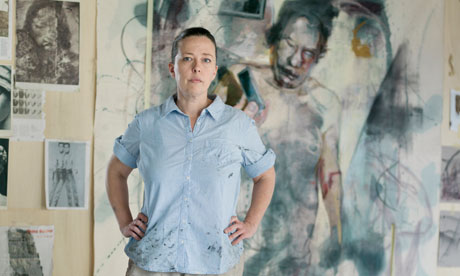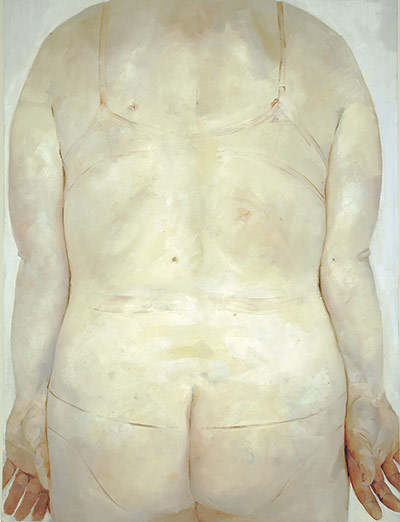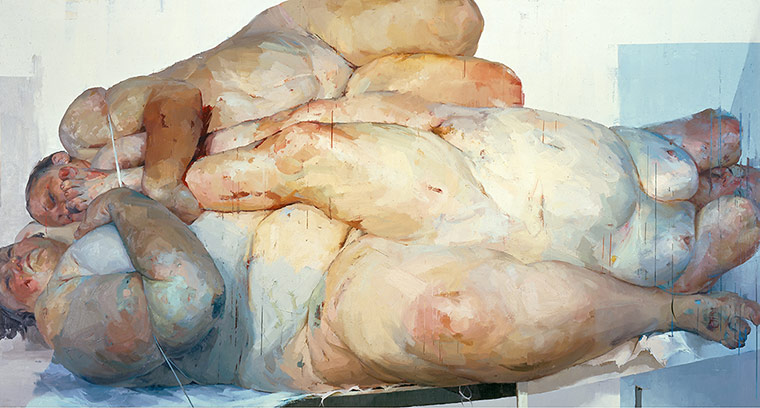Jenny Saville's work has always been inspirational for my practice. I love the boldness with which she presents bodies which do not fit the conceptual ideal of body politics, the fit slim youthful body of advertising agency, a cultural zeitgeist which all too often leads to the rejection of those whose bodies do not match up to the cultural ideal. A large part of my work is about challenging these cultural stereotypes, by presenting bodies which are not ideal, flesh which is distorted and grotesque. As a figurative painter I have tried to learn from Saville's work, by looking closely at how she paints flesh, and trying in my own way to emulate it.
Mark Stevens, "Fresh Meat," New York Magazine (December 13,1999):
"Saville's art is the dark reflection of contemporary fashion. In the mind of many
people, the power of the mass media—as they present their array of svelte
bodies—creates a tyranny of perfected form. What is left for art, then, but to
disturb the shiny abstractions of advertising with a gutty touch? To remember
that not all bodies are beautiful and to declare, rudely, that in our culture the body
is treated as meat? Even the models in the magazines and the talking heads on
TV are just something to be consumed. That Saville's work should itself become
fashionable, taken up by advertising magnates, is not surprising in this world of
mirrors. Her work invites the paradox; it sends contrary signals. She shows off
an unflinching eye, but also has a silky brushstroke that's sometimes reminiscent
of Sargeant. These are not just bodies—they are our body politic."

 Maria Joscelyne Castaneda
Maria Joscelyne Castaneda -In Trace, for example, Saville paints the back of a woman wearing "trace" articles of clothing. The back of this anonymous figure becomes an intimate portrayal of an
aspect of the body that is not often surveyed. Her arms appear to squeeze tightly to her
sides as if she wants to fit within the proportions of the canvas. Her skin is mottled,
speckled with bits of grey and white and the occasional shades of pink and yellow. The
skin is uneven in coloring, especially where the paintwork appears to have been applied
in varying quantities. This stylistic quality is also evident in Plan where her skin color is
not one shade but many. The skin is so pale that it is almost transparent conveying the
vulnerability and permeability of flesh; though these bodies may be solid they are also
fragile. Saville understands the human body and women who are so dissatisfied with
their shape that they ultimately turn to surgery. Saville, in turn, "uses the paint as if it is
flesh, sculpting it as if she is a surgeon."
[Loren Erdrich, "I am a Monster: The Indefinite and the Malleable in Contemporary Female Self-Portraiture," Circa 121 (Autumn 2007)]
Linking to Maria Joscelyne Castaneda's Thesis for Master of Arts in Art History, University of California Irvine
Abstract:
Jenny Saville's unusual take on the figure has framed her
paintings within a context all too receptive to the cultural biases
constructed around fat and female bodies. In order to rethink the
fleshy, expansive bodies that Saville portrays, I position her art
historically within a contemporary shift away from traditional
figuration towards a new, more visceral focus on the body. The broader
body politics within which she works are also examined through a
historical study of how hysteria has become aligned with eating
disorders, resulting in a cultural affliction that makes the female body
a site of public domain and critique. Rather than reading Saville's
bodies as examples of fat and repulsion, I suggest that her oversized
female bodies be viewed as embodiments of Mikhail Bakhtin's concept of
the grotesque body—a liberating and boundless body capable of subverting
hierarchical systems and standardized norms.
Full thesis available for download here
http://gradworks.umi.com/14/72/1472266.html











































